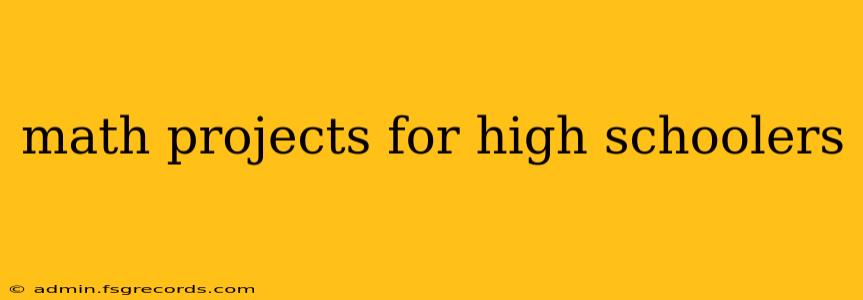High school math can sometimes feel like a series of abstract concepts and formulas. But what if we could transform those concepts into engaging, real-world projects that ignite a passion for mathematics? This article explores a range of math projects suitable for high school students, catering to various skill levels and interests. We'll delve into the benefits of project-based learning in mathematics and provide you with examples to get started.
The Power of Project-Based Learning in Math
Traditional math education often focuses on rote memorization and standardized testing. However, project-based learning offers a dynamic alternative. By tackling real-world problems using mathematical tools, students develop:
- Deeper understanding: Applying concepts to practical situations solidifies understanding far better than simply solving textbook problems.
- Problem-solving skills: Projects require students to analyze problems, devise strategies, and persevere through challenges—essential skills applicable beyond mathematics.
- Critical thinking: Students must evaluate data, interpret results, and draw conclusions, fostering critical thinking abilities.
- Collaboration and communication: Many projects involve teamwork, enhancing communication and collaboration skills.
- Increased engagement: Engaging with a topic through a project makes learning more enjoyable and memorable.
Math Projects by Skill Level and Interest
Here are some math project ideas categorized by skill level and area of interest:
Beginner-Friendly Projects:
- Geometry in Art and Architecture: Analyze the geometric shapes and patterns in famous artwork or buildings. Calculate areas, volumes, and angles. This project combines math with art appreciation.
- Budgeting and Personal Finance: Create a personal budget, exploring concepts like percentages, interest rates, and compound interest. Students can simulate saving for a car or college.
- Data Analysis of Everyday Life: Collect data on a topic of interest (e.g., weather, sports statistics, social media trends) and analyze it using basic statistical methods (mean, median, mode, graphs).
Intermediate Projects:
- Modeling Population Growth: Use exponential growth models to predict the population of a city or country based on historical data. This introduces students to the power of mathematical modeling.
- Creating a Game with Mathematical Rules: Design a board game or card game with rules based on mathematical principles (e.g., probability, geometry). This project blends mathematics with creativity and game design.
- Exploring Fractals: Investigate the fascinating world of fractals, visually representing mathematical sequences and exploring their properties. This project can be visually engaging and introduce concepts of iteration and self-similarity.
Advanced Projects:
- Mathematical Modeling of a Real-World Phenomenon: This could involve anything from modeling the spread of a disease using differential equations to simulating the trajectory of a projectile using physics equations.
- Cryptography and Encryption: Explore the mathematical principles behind cryptography and design a simple encryption/decryption algorithm. This project connects mathematics to computer science and cybersecurity.
- Statistical Analysis of a Research Question: Students can formulate a research question, collect data, perform statistical analysis, and draw conclusions, mirroring a real scientific study.
Tips for Success
- Clearly defined goals: Ensure students understand the project's goals and requirements.
- Structured timeline: Break down the project into manageable tasks with deadlines.
- Regular feedback: Provide regular feedback and guidance to keep students on track.
- Presentation of findings: Encourage students to present their findings creatively, whether through a poster, presentation, or written report.
By engaging in these projects, high school students can transform their perception of mathematics from a set of abstract rules to a powerful tool for understanding and shaping the world around them. The key is to encourage exploration, foster curiosity, and celebrate the joy of mathematical discovery.

